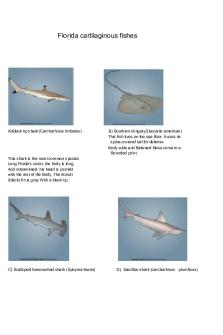Dichotomous Keys PDF

| Title | Dichotomous Keys |
|---|---|
| Author | Holly Marie Bernardino |
| Course | Foundations of Biology: Reproduction and Development |
| Institution | California State Polytechnic University Pomona |
| Pages | 2 |
| File Size | 139.5 KB |
| File Type | |
| Total Downloads | 59 |
| Total Views | 147 |
Summary
Download Dichotomous Keys PDF
Description
Holly Marie Bernardino April 9th, 2020 BIO1220L BIO 1220L Lab 10 — Creating and Using Dichotomous Keys EXERCISE 1: USING A DICHOTOMOUS KEY The identification of five unknown plant species. Include with each the leads you selected to arrive at your answer (for example—1, 2, 3’ for brittlebush, Encelia farinosa). Unknown Species A: 1’, 7, 8’ for California black walnut, Juglans californica Unknown Species B: 1, 2’, 4’, 6 for coast live oak, Quercus agrifolia Unknown Species C: 1, 2’, 4’, 6’ for white alder, Alnus rhombifolia Unknown Species D: 1’, 7, 8 for blue elderberry, Sambucus mexicana Unknown Species E: 1, 2, 3’ for brittlebush, Encelia farinosa EXERCISE 2: CONSTRUCTING A DICHOTOMOUS KEY Using the space below, construct a bracketed dichotomous key using hypothetical creatures. Select eight of the Caminalcules and give them names (as opposed to the numbers currently used to identify hem). Use the characteristics in the provided diagram below to help write the leads of your dichotomous key.
EXERCISE 3: WHY ARE DICHOTOMOUS KEYS ARTIFICIAL? 1. Are dichotomous keys used for the same purpose as phylogenetic trees? Dichotomous keys could be used as the same purpose as a phylogenetic tree. However, dichotomous keys are used to determine and identify certain characteristics and to split up species. Phylogenetic trees show the lineage of species throughout time, as well as the organization of organisms. Phylogenetic trees show how things have changed over time, while dichotomous keys are highlighting the specific changes. Phylogenetic trees display the evolution of traits. 2. Do dichotomous keys reflect evolutionary histories and relationships? No, they do not. They only reflect certain characteristics that distinguish organisms into specific categories. They allow for humans, especially scientists to distinguish and identify organisms that are unknown as if they were trying to find clues to solve the puzzle. You could have an organism that is completely unrelated to another organism, but they would be “connected” through having a certain trait that does not even define a history or direct relationship. They could hint at relationships if one notices similarities amongst certain traits....
Similar Free PDFs

Dichotomous Keys
- 2 Pages

Dichotomous Keys gizmo
- 6 Pages

Dichotomous Keys SEgizmo
- 30 Pages

Practical 3 Dichotomous Key
- 9 Pages

Compustat keys
- 26 Pages

Dichotomous Key Homework 1
- 2 Pages

Dichotomous key lab modified
- 9 Pages

Lab: Using a Dichotomous Key
- 5 Pages

Day 145 candy dichotomous key
- 1 Pages

Chapter 5 Answer Keys
- 43 Pages

GU0104 Shortcut Keys - Altium
- 15 Pages

Cats-3 - Sample Dichotomous key
- 2 Pages
Popular Institutions
- Tinajero National High School - Annex
- Politeknik Caltex Riau
- Yokohama City University
- SGT University
- University of Al-Qadisiyah
- Divine Word College of Vigan
- Techniek College Rotterdam
- Universidade de Santiago
- Universiti Teknologi MARA Cawangan Johor Kampus Pasir Gudang
- Poltekkes Kemenkes Yogyakarta
- Baguio City National High School
- Colegio san marcos
- preparatoria uno
- Centro de Bachillerato Tecnológico Industrial y de Servicios No. 107
- Dalian Maritime University
- Quang Trung Secondary School
- Colegio Tecnológico en Informática
- Corporación Regional de Educación Superior
- Grupo CEDVA
- Dar Al Uloom University
- Centro de Estudios Preuniversitarios de la Universidad Nacional de Ingeniería
- 上智大学
- Aakash International School, Nuna Majara
- San Felipe Neri Catholic School
- Kang Chiao International School - New Taipei City
- Misamis Occidental National High School
- Institución Educativa Escuela Normal Juan Ladrilleros
- Kolehiyo ng Pantukan
- Batanes State College
- Instituto Continental
- Sekolah Menengah Kejuruan Kesehatan Kaltara (Tarakan)
- Colegio de La Inmaculada Concepcion - Cebu



